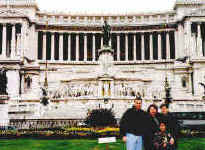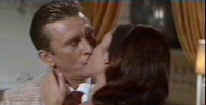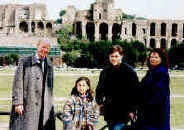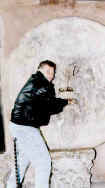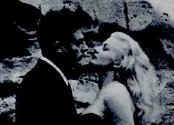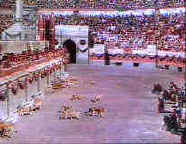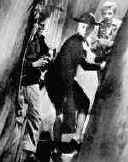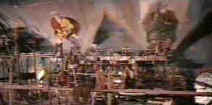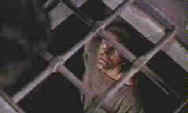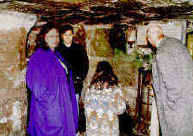Roman Holiday
Touring Rome with movies in mind.
By Stuart J. Kobak
|
|
|
Greg and Audrey at enjoy one of the many views in Roman Holiday. |
Roman Holiday: the
movie was a fairy tale concocted for Hollywood and greedily consumed by a public delighted by the
perfect bon-bon of a film. But the film did more than just enchant movie-goers It didnít only
make a star of Audrey Hepburn It didnít only free Gregory Peck from the weight of all his serious
roles. It enticed a growing number of post war Americans to cross the Atlantic in search of
European sophistication and history. All roads supposedly lead to Rome but all Roman holidays are
not necessarily Roman Holiday. So, when I call this jaunty article "Roman
Holiday," I donít think I am lifting the title from the creators of that wonderful movie,
but instead it is meant as an homage to Hollywoodís creative juices at their most charming. This
is my "Roman Holiday," joined together with the many views of the ancient city that
Hollywood has conjured for film lovers.
My first trip to Rome and as a foursome with the family, my wife Dorothy
(age unknown), Alex the Duke freshman, and Elizabeth, the seven-year-old bundle of energy. Maybe
not as romantic as Greg and Audreyís night, but what an awesome trip. This was going to be a
winner from that first moment on entering Rome when the limo driver turned out to be a virtual
fountain of information about Rome and Hollywood. Perfect for this city of fountains.
|
|
|
The Kobak family in front of Victor Emanuel's "Wedding Cake." |
Roman Holiday is a
splendid tourist movie. It provides several excellent locations to hunt down a recreation of
special film moments.
It was a bit cool when we visited the Spanish steps that first day
but our view was every bit as good as Audreyís. And my seven-year-old Elizabeth did a double
dipper of ice cream in memory of Audreyís innocent appetite. The hawkers selling colorful
balloons filled with sand as malleable sculpture toys may have been less erudite than the street
artists that caught the attention of Kirk Douglas and Deliah Lavi strolling down the
"Steps" in Two Weeks in Another Town. Leave it to director Vincente Minnelli to
find art as a focus to dress the Spanish Steps.
|
|
|
Douglas through the brass doors of the Excelsior in Two Weeks in Another Town |
Ah, the Excelsior. Located at the apex of the Via Venato, the Roman avenue made so fashionable by Fellini in La Dolce Vita, the hotel still rises regally above the street commanding Fellinesque attention. A magic hotel where film icons changed persona as they moved through the brass revolving doors. Thatís where the stars of Two Weeks in Another Town played out their big scenes. Funny, we didnít notice the ghost of Edward G. Robinson as film director Maurice Kruger ordering people around the lobby. Kirk Douglas wasnít chasing any skirts or fleeting fame either. The Kobak crew didnít even get movie star treatment from the hotel and the restaurant recommendations-well, the miserable restaurant guidance from the concierge, thatís a depressing degustibus of a totally different tenure. Lex Barker, would have probably punched the concierge out just as he did Marcello Mastroianni in front of the Excelsior in La Dolce Vita. Me. I just punch people out for talking in movie theaters.
|
|
|
Kirk Douglas in Two Weeks in Another Town |
Taxis were our preferred mode of transport through the piazzas and traffic of Rome. No, we didnít quite wind up with a driver of the manic magnitude of Roberto Bernigni, the cabby of the Rome segment of Night on Earth, a film depicting night time cab rides on five cities. Our most outrageous cab moment came when our driver couldnít find the restaurant we were going to, couldnít read his street map adequately, and preceded to have a heated battle with several other cabbies when he stopped to get directions. They berated him unmercifully in broad arm movements for his ignorance of Roman streets and he made a heated retreat to our cab punctuated by a classic Italian hand motion. We got to the restaurant, eventually, and an overpriced, poorly delivered lamely conceived meal.
|
|
|
Edward G. Robinson (right) as Maurice Kruger in Two Weeks in Another Town |
Maybe we should have tried the motor scooter school of touring with Nanni Moretti as guide. There are roads in Rome that are not typical tourist terrain. In Caro Diario, for half the movie, you can follow Nanni Moretti on his motor scooter through residential areas of Rome, many Roman scenes off the typical tourist beat. This is the lived in Rome. The pervasive pale orange of historic building facades dominates the color scheme Moretti displays a fascination with the Roman architecture. His camera caresses the buildings.
|
|
|
Mercedes guide shows Kobaks Circus Maximus |
And there at least one shot of a fountain in Caro
Diaro, two lions regally spewing clear liquid back into the pool. On the Moretti beat, you
might also wind up in the middle of a festive street concert and slip onto the stage for an
impromptu chorus with the band and then cut in for a spin on the piazza dance floor a la Moretti.
Like Greg and Audrey in Roman Holiday you might encounter dance festivities along the Tiber
River or maybe like Mastroianni and his sophisticates trip the light fantastic outdoors with an
Anita Ekberg.
The best touring was with limousine driven by our Hollywood expert. The line
snakes through the street like the asp circling Cleopatraís body, a string of tourists, mostly
Japanese, that have disembarked from a number of tour buses and converges on one of those picture
perfect Roman photo ops .Itís the Santa Maria Basilica that they are lined up outside and on a
wall under the entry portico is the stone face of a hungry human, mouth slightly open awaiting
provender, through which every one of these sightseers is waiting to place their hand, just as
Gregory Peck did with such refreshing aplomb in Roman Holiday. That beauty of a flick,
filled with the fresh flowers of innocence arranged with grand panache by director William Wyler
inspired every one of us tried our hand at feeding the face. It was worth the wait to feed the
mouth that provided such insouciant joy in Roman Holiday. No one lost a hand.
|
|
|
Author at the mouth of truth. Ouch |
We didnít get the same greeting at Cinecitta, the legendary Italian film studio on the outskirts of Rome, that Kirk Douglas got from Edward G. Robinson in Vincente Minnelliís Two Weeks in Another Town. In his follow-up Hollywood essay to The Bad and the Beautiful, Minnelli delivers a mini-tour of Cinecitta . The widescreen image frames the long, plain entrance to the Roman dream factory. Inside, camera booms, movie stars, romantic lagoon and all. Back at the Excelsior again, Kirk Douglas and Edward G. Robinson are installed in the most luxurious suites. The elegant entry to the Excelsior Hotel is a revolving door of delights through Minnelliís lens. In reality, tourists like us faced carrion cabs feeding on fares rather than a phalanx of paparazzi that greeted the stars of Two Weeks in Another Town or La Dolce Vita.
|
|
The showers at the Excelsior were terrific. The water pressure in Rome is so fantastic that we felt clean enough to skip the Caracalla Baths. Celluloid tourists can catch a night view of them in La Dolce Vita with buxom Anita Ekberg as dressing. Sorry, gang, the only bathing she does is fully dressed in the Trevi fountain. Now that is a great scene as voluptuous Ekberg strides purposefully into the fountain with this enormous thirst for life. Mastroianni follows her into the now sensuous waters hungrily. No, the Kobaks did not dip their toes into the sacred waters of the Trevi. Recently though, the Italian courts found enterprising coin collectors "Not Guilty" of any wrong-doing when they ventured into the Trevi to fish out the mountain of tourist gold left for luck and the patrons of Triton.
|
|
|
Ekberg and Mastroianni in the Trevi Fountain from La Dolce Vita |
Listen to the water at the Trevi Fountain. In reality, itís difficult to talk over the constant roar. When Jean Negulesco filmed Three Coins in the Fountain he had to accommodate to film reality and filter out some of the noise so the dialogue could be reasonably heard. The roar becomes a twinkling brook as all three romances are reunited at the Trevi Fountain and the music fades out on the faded print used as the source for this laser disc.
|
|
|
Three Coins in the Fountain(The Trevi) |
Three Coins in the Fountain has more travelogue footage in it than most travelogues, but it definitely adds color to an otherwise stilted script. By the filmís end weíve had glimpses of some of the best Roman sites, including St. Peterís Basilica, the Coliseum, the Roman Forum, and even a passing peak at the grand spectacle tourists typically refer to as the wedding cake, Italy's 1911 monument to King Victor Emanuel under whom the country was united.* Donít try to count the fountains that lead into the credits as Frank Sinatra croons the title song. All I can say is that I canít believe I missed so many plumes of water. When in Rome take a cue from director Jean Negulesco: see all the fountains you can. A good guide will have a story for each fountain bringing greater clarity to the flowing waters.
|
|
The last thing on your mind on entering the Coliseum is water or Anita Ekbergís wet frolics. There is silence that exists as much from the vast openness of the crumbling structure as to the reality of the horrors that took place in the arena. The catacombs of the Coliseum are exposed where the arena surface has been and one immediately begins to conjure images of the lions and Christians and screaming crowds rejoicing in the blood spectacle. Can you imagine standing in the middle of a crows of 150,000 screaming people, not knowing just what was going to happen. What fear. I thought of Deborah Kerr awaiting the wrath of the hungry lions in Quo Vadis. Of course, the Christians in these films are armed with their religion as well as the knowledge that this is only a movie and the lionís have fewer teeth than MGMís Leo. Lying regally like true descendants of the lions there are cats in every cool cubby of the Coliseum. On the outside the nearly two thousand year old structure looks like another decaying Roman relic, but once through the gates, the incredible expanse of the arena is breathtaking.
|
|
|
Nero's Circus in Quo Vadis |
Actually, I was mistaken about the Coliseum as a setting for Quo Vadis. So much for dusty film memory. The structure had not yet been built when the despicable cruelty of Neroís Rome unfolded in Circus Maximus. Standing on the edge of the massive circus site, our guide described how the famous chariot race in Ben Hur encompassed six passes around dusty track. You got to check your sources. The guide naturally was grossly mistaken about Hurís horse trip since the chariot race in Ben Hur takes place in a different circus in Palestine The scale of Circus Maximus though must have been the inspiration for the construction of the fantastic set in Ben Hur where the great chariot race unfolds in all itís widescreen power.
|
|
Fellini plastered Ekberg all over Rome in La Dolce Vita. What better view of the winding steps leading up the Dome of St.Peterís than of the statuesque actress coyly posing at one of the windows that provide a momentís respite from the arduous climb toward the top of Rome. Unlike the breathless tourists panting their way to the top, Ekberg was a cool Nordic customer in her effortless climb. I wondered if they carried her up on a celluloid palanquin. Yes, we made it to the top and the view was more imposing than anything Fellini presented in his masterpiece. When youíve lost your breath in furious climb whatís left to give to a breathtaking view?
|
|
|
Liz at the Coliseum |
A visit to The Sistine Chapel from St. Peterís is sensible, though it wouldnít be a bad idea to set aside a separate day. Michelangelo laid hunched on his back for five years to paint the spectacular vaulted ceiling of the sanctuary on the commission of Pope Julius II. The Agony and the Ecstasy, starring Charlton
|
|
|
Painting The Sistine Chapel in The Agony and the Ecstasy |
Heston as Michelangelo, recreates the painting
of the Sistine Chapel by the master and focuses most bitchingly on his relationship with Julius.
The film lacks great drama but is seasoned by the oil of Heston and the vinegar of Rex Harrison,
playing the pope with scathing sibilants. Itís easy to dismiss Hestonís work in the intense
presence of the real thing, though the film presented a magnificent sense of the scope of the work
with thrilling color.
Tucked quietly between the sites of the major Forums of ancient Rome, our
guide struck cinematic gold for me when he took us to the oldest extant jail of the city. At the
bottom of the small, cold damp structure, after twisting down the steps, I looked up and there was
a metal grating to the next level. Other tourists looked down on us. I was immediately and
powerfully struck by the similarity of the cells where Spartacus was kept during his
training in the gladiator school. It mattered not that the scene didnít take place in Rome. The
poignancy of the moment when Spartacus is given an opportunity to be alone with the woman
Varinia only to look up at trainer Charles McGraw leering down at them brought added meaning to the
confines of the dark and lonely cell and the time of slavery and the power and control of the Roman
Empire.
|
|
|
Spartacus looks up from his cell at the guard spying on him and Varinia |
The Bird With a Crystal Plumage presents some views of Rome that were clearly avoided by a tourist family like mine. This dark film finds shadows and danger lurking behind every ancient facade of civility or barbarism. Dario Argentoís dark sensibilities invest every turn of a street corner with malignant danger. The widescreen cinematography of Vittorio Storaro embellishes the film with menace, capturing a claustrophobic view the eternal city. Not recommended to inspire tourists for those romantic late night Rome walks. How about a "stalking tour of Rome." But we survived the varied sites, the tourist traps, the scraps of culture scattered through the breadth of Rome, with nary a close encounter of the disagreeable kind.
|
|
|
The Kobaks at the oldest jail in Rome |
If itís true that all roads lead to Rome then all roads lead out of Rome too. And all trips have to end. Sitting on the plane on the way home from Rome, I couldnít help thinking about poor Charlton Heston who can prominently to mind at several Rome tourist spots. The man was hunched over for all those years painting the Sistine Chapel could at least have had a trip to Rome in Alitaliaís Magnifica Class, a far cry from his journey as Ben Hur. Let me tell you, that guy can sure row. Talk about a fitness fanatic, Hur/Heston subscribed to a slave galley as opposed to joining the local health club to achieve superb conditioning for withstanding the slithery delivery of Messala in the great chariot race of Ben Hur. After all that eating in Italy, my next trip maybe I should subscribe to the Hestonís preferred mode of travel. I guess he was afraid of flying.
|
|
|
Row well and live #41(Ben Hur) |
The next time the Kobak family takes flight to some exotic locale, we are absolutely going to spend time with features films that shed some light on our destinations. Our Roman holiday could have been even more fun armed with celluloid intelligence about the various locations we toured. Itís a unique and thoroughly pleasurable way to research a trip.
On DVD
It appears that the DVD transfer for Spartacus is made from a composite master, thereby losing out on some of the most important DVD benefits. There is also some edge enhancement that detracts from the image. The widescreen images of Spartacus would have surely benefited greatly from an anamorphic component transfer. Still, this is the best Spartacus has looked since the Harris/Katz restoration. The color is full range and seldom looks worn. Difficult scenes that depend on shadow detail, like when Spartacus first meets Varinia are well handled. The Dolby Digital 5:1 sound is clean and shows off the Alex North score handsomely. I must say that I was pining away for the marvelous commentary extras that appeared on the Criterion Collection special edition of a number of years ago. C'est la DVD.
All I can say is: ďJudahÖBen Hur.Ē Maybe I canít deliver
the line with the wonder of Sam Jaffe as Simonides, but in this case I can echo the sentiment at delighted wonder that
Jaffe incanted. Much of the new Ben Hur DVD looks spectacular. The image benefited from
moving the sharpness control from its normal off position, which is somewhat dismaying. With the
sharpness amplified sparingly on Ben Hur, most of the images are crisp without any residual
edginess. Without careful monitoring, uses of the sharpness control often degrades overall picture
performance. There are a couple of scenes where peak transitions ring, but these are very few and
would not be eliminated with the sharpness control off. The color appears to have been restored
during the transfer stage. The old laser disc had some nasty color fading and the left 25% of the
screen in some scenes seemed to be mastered from totally different elements (Not the case of
course). Now the color is uniformly vital. The blue
skies are lustrous and pure. Which leads to a question of the apparent absence of film grain. Now,
I am not saying the picture was not pleasing to me sans any hint of film grain, but I wonder if the
grain was wiped out in the transfer in some way. This might be robbing some character from the
image. The night scenes do not fare as well as they
should have. Blacks donít even look like they are being rendered by a CRT projector; more like a
middling DLP or LCD. The resultant image lacks depth, seems flattened out. My first notice of this
problem occurred early on in the scene in which Messala with Sextus on his arrival in Judea. Itís
worse later in some scenes with Heston and Harareet to some degree in their first love scene and
later in some outdoor courtyard sequences. The worst example is the revelation scene when Hurís
family is blessed by Christís miracle. There is some slight horizontal jitter in the opening
credits, but I did not notice it in the picture after that., happily. This is by far the best I
have seen Ben Hur look since I sat cramped in the balcony of the Loews State Theater in
1959, my knees propping up my chin. Maybe it even looks better. Itís certainly the best video
incarnation of the great widescreen spectacular.
The newly mixed Dolby Digital 5:1 surround sounds great to my ears. The roar
of the crowd filled my home theater with a cacophonous din during the chariot scenes. Miklos
Rozsaís magnificent score is simply wonderful, with an open, orchestral front sound field. I
donít want to get into the issue that this is not the original mix for the film, the stereo
dialogue having been remixed to a mono center channel. I have always found the old stereo dialogue
mixes mostly disconcerting. I feel somewhat blasphemous since I am a stickler for delivering the
proper aspect ratios of films. However, the dialogue is very clear and sense of who is speaking is
never in question.
On Laser Disc
The laser discs are a mixed bag for laserphile tourists. A brief description of the discs follow in the order of the year the films were made.
Quo Vadis, made in 1951, is representative of the pinnacle of the MGM color spectacle. The scenic recreations are brilliant and the laser captures the opulence of decadent Rome handsomely. There is some color shifting between scene transitions, but it is minor. The 102 minute film is given a sharp transfer.
Roman Holiday is an old pressing that stands up very well to the rigors of todayís fanatical inspection. Images from the 1953 film are sharp and contrast reasonably good on this laser. The source material has some blemishes, but they present no barrier to the realities of Rome. Definitely a film for any collection. Still, Pioneerís LDC has announced a new pressing from Paramount on the way of this 133 minute classic.
The Trevi is just one of the fountains that come to lively life in the 1954 Fox Video Three Coins in the Fountain. Itís a dated romantic tale with limited modern appeal presented widescreen 2.40:1. Rome and the opening fountain montage accompanied by Frank Sinatraís wonderful rendition of the title standard are the highlights of this film. The laser disc is quite sharp, often overly enhanced producing excessive aliasing(inter-line flicker). Color is slightly pasty. The stereo sound adds moderate appeal to the 102 minute film.
The source material for 1960ís La Dolce Vita is pretty darn good and other aspects of this transfer stand up well. The image of the 172 minute film is presented in a 2.10:1 aspect ratio, just shy of its original 2.35:1 composition without apparent artistic compromise. Black and white contrasts are good and the English subtitles are presented in white in the lower black band of the letterboxing.
Spartacus is a laser of immense importance, especially the Criterion Collection edition which provides marvelous commentary by principals of the film including Kirk Douglas, Howard Fast, and Peter Ustinov. The transfer is a beauty coming after extensive restoration of the film. Spartacus, also available from MCA in an identical transfer, is an immaculate and sharp laser disc with numerous convenient chapter stops. Delivered in a 2.20:1 widescreen ratio, the 1960 film runs 184 minutes
Vincente Minnelli and color: the musical stylist knew how to make beautiful pictures on the screen and Rome comes across wonderfully in the 1962 Two Weeks in Another Town. Itís an excellent laser disc from MGM transferred in its original 2.35:1 aspect ratio. Sharp images, rich color, enviable contrasts. The mono sound is very clear. This first class disc for movie loving tourists delivers a 107 minute Minnelli feast.
The Agony and the Ecstasy, released in 1965, is painted in the glorious tones of Papal Rome as Michelangeloís frescoes come to life with virgin brilliance. The disc is very sharp but there are resultant artifacts of excessive aliasing as a result. The 139 minute spectacle is presented in stereo with a 2.35:1 aspect ratio.
The Bird the Crystal Plumage, 1969, was delivered on disc in an English language version with an aspect ratio of 2.20:1. The dark images of the 98 minute film are grainy at best and my copy of the disc which came out six years ago has long since given in to laser rot forcing Tony Musante to hunt the slasher through an oxidation induced hail of laser snow.
Jim Jarmuschís 1991 Night on Earth fares well on laser with a crisp transfer in a 1.66:1 aspect ratio. The stereo surround has good pop on this 128 minutes laser disc set.
Caro Diaro made in 1994 is a most delightful laser disc that can provide companionship on any number of jaunts through Rome and Nanni Morettiís life. The colors on this 1994 film are tour guide bright and the images are sharp. The 100 minutes of Morettiís vision is seasoned by an excellent stereo surround sound track with excellent impact on the laser. The laser is widescreen 1.66:1 and the Italian is translated with easy to read yellow English subtitles.
*Thanks to reader Jun Yan who pointed out an error details concerning "The Wedding Cake."
![]()
Selections from the feature archive include articles on Akira Kurosawa,
Frank Darabont, Blonde Bimbos, Hollywood Street Gangs,
or Vietnam: The Hollywood Pariah,
and many more....
The Exquisite Muse of
Zhang Yimou

The powerful image-making of Zhang Yimou has revealed itself in
virtually every film he has made. Coupled with his remarkable collaboration with actress Gong Li,
Zhang's has built a stunning body of work Click the image to read all about it.
![]()
![]() Gary Morris's insightful publication Bright Lights
Film Journal turns the celluloid in films from a unique perspective. Click on the image above
for more pure movie views.
Gary Morris's insightful publication Bright Lights
Film Journal turns the celluloid in films from a unique perspective. Click on the image above
for more pure movie views.
![]() Lovers of
Hong Kong movies will relish MC4's
site that includes reviews and other information about the Hong Kong movie scene.
Lovers of
Hong Kong movies will relish MC4's
site that includes reviews and other information about the Hong Kong movie scene.
 The online site for Film Comment Magazine
includes all the information you need to know about cinematic events sponsored by the Film Society
of Lincoln Center.
The online site for Film Comment Magazine
includes all the information you need to know about cinematic events sponsored by the Film Society
of Lincoln Center.
![]()
DVDPlanet is the DVD
incarnation of legendary laser retailer Ken Crane's. Deep discounts and serious service.
![]() Direct from the corridors of the Home Theater Forum, Home
Theater Talk is the newest place on the Net to discuss everything home theater. Friendly atmosphere
and knowledgeable folks are the secret ingredients.
Direct from the corridors of the Home Theater Forum, Home
Theater Talk is the newest place on the Net to discuss everything home theater. Friendly atmosphere
and knowledgeable folks are the secret ingredients.

The American Widescreen Museum, is the ultimate resource for widescreen movie information, Martin
Hart's reliable site is a great tool for movie buffs.
![]()
Specializing in DVD reviews, DVD Authority boasts almost 400 reviews in an easy to use, elegant,
interface.
They may be judgmental, but that's the point, isn't
it. Lots of DVD reviews plus news and more.
Click on the link to visit the judge's chambers.
The Movie Poster Archive include extensive poster images from the films of stars like Susan Hayward, Kirk Douglas, Katharine Hepburn and many more. Our featured star is Clark Gable.
Click on the DVD MIA symbol for
profiles of DVDs missing in action.
Add films to the DVD MIA Master List by filling out
a simple form. Click Here
During World War II, Hollywood pumped out war movies one after the other. Vietnam was was another story. As far as Hollywood was concerned it was a pariah.

